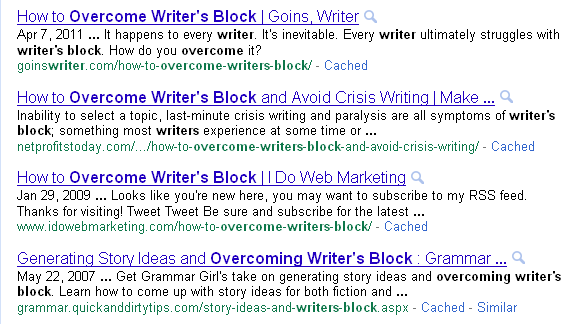As writers, we fuss over the appearance of our blogs. When we publish articles, we take time to choose the best words to communicate our thoughts. The presentation of our work is important to us. Why is it then, that most writers don’t optimize their posts to look good in search engines?
After all, we want people to find our posts, visit our sites and read our musings. So why not improve our chances of getting chosen?
This article is not about search engine optimization (SEO). I’m not going to tell you how to improve your ranking in the search results. That’s a complicated subject best left for experts like . Instead, I’ll show you how to optimize the appearance of your listings, making them more enticing and improving your chances of getting selected.
Real World Examples
Let’s look at some sample search results. On Google, I searched for “overcome writer’s block.” I selected these four entries from the results.
Look them over. Which one would you pick first?
I’d be willing to bet you didn’t choose number three. Why? First off, the name of the website, I Do Web Marketing, doesn’t sound inviting (at least not to writers). But more importantly, the description tells us nothing about the post. The author’s well-intentioned effort to welcome visitors is chasing them away before they get there.
I’m a big fan of Grammar Girl. I would have chosen their link (number four) had I noticed. But because the post title is so long, the site name in the title got truncated. As a result, the link isn’t branded and clicks will go elsewhere.
The second entry suffers from the same problem: site name truncation. But in this case, that might be a good thing, since most writers would avoid a site named “Net Profits Today.”
I haven’t criticized the first listing — because Jeff Goins does everything right. So I’ll use his as a model for the rest of us to emulate.
View Your Search Engine Listings
Want to see how your posts are listed in search engines?
Here’s a tip that most don’t know. In the search box at Google or Bing, type “site:” followed by your domain name. Be sure not to leave any spaces.
I’ll make it easy. In the search box below, replace FirstManuscript.com with your domain name. When you click the Submit Button, the results will be shown on a new page.
If you are pleased with the way your posts are displayed, then I’ll tip my hat to you and send you on your way. If not, in the next section, I’ll show you how to make improvements.
Best Practices (Theory)
Now that you’ve viewed your posts on Google, let’s look at Jeff Goins’ search engine listing again, while we explore best practices.
Here are the best practices for search engine listings:
Title:
- Make it relevant
- Give it some pizzazz, when possible (the goal is to get noticed)
- Place the keywords in the title (the words you expect people to use when they search)
- Avoid long article titles (titles get truncated when they are over 60 characters or so)
- Include your site name (place it after your post title using a separator)
Moz has an excellent webpage on optimizing page/post titles.
Description:
- Short and concise
- Make it compelling
- End with a call to action, an unanswered question or some unresolved issue that entices them to click.
- The maximum is around 155-160 characters (it depends on the width of the characters). Anything longer gets truncated and an ellipsis tacked on.
Once again, Moz has a great page on optimizing page/post meta descriptions.
The Link
- Use permalinks (how-to-overcome-writers-block and not p=153)
Best Practices (Execution)
In the real world, putting this into practice is difficult. Which is why many avoid the topic.
In particular, the description is problematic. By default, most of the time, the search engines will select a relevant snippet of text from your post for the description. Most often, they grab the first part of the opening paragraph. The results are normally sub-optimal.
For those of you using free hosted sites (like Blogger.com and WordPress.com), I don’t believe there’s an easy way to set a description for each post. You’ll be stuck with the snippets chosen by the search engines. (Which is one reason I recommend that serious bloggers set up their own sites.)
For those of you not on the free sites, you’re in luck. With a little effort, you can outshine others by providing the descriptions you want listed. If you are using WordPress, you’ll need to install a plugin that allows you to specify a different meta description with each post.
I recommend the WordPress SEO by Yoast plugin. It integrates directly into the edit post page. It displays your post’s listing as it will appear in the search engines, and it allows you to override the title and give your own description (and a lot more).
Summary
Once you understand the concepts, making your posts search engine friendly requires a little extra work. The return on that investment will be more visitors.
If you have questions, enter them in the comments below.
Comments
Related Posts

Beta Reader Instructions
After you type those magic words (THE END) into your manuscript, you will want to have a few beta readers review it. Here are the instructions I give my beta readers.

My Inside-Out Character Development Model
To develop realistic characters that engage readers, I use an inside-out character development model. Here is how it works.

Is it All Right to Write Alright?
Is it all right for you to write alright? Here’s what you need to know to get it right.

Writing Assistance? Even the FBI Will Help!
Being a newbie author, I needed all types of special assistance. To my surprise, I found nearly everyone I asked willing to help, even the FBI.




